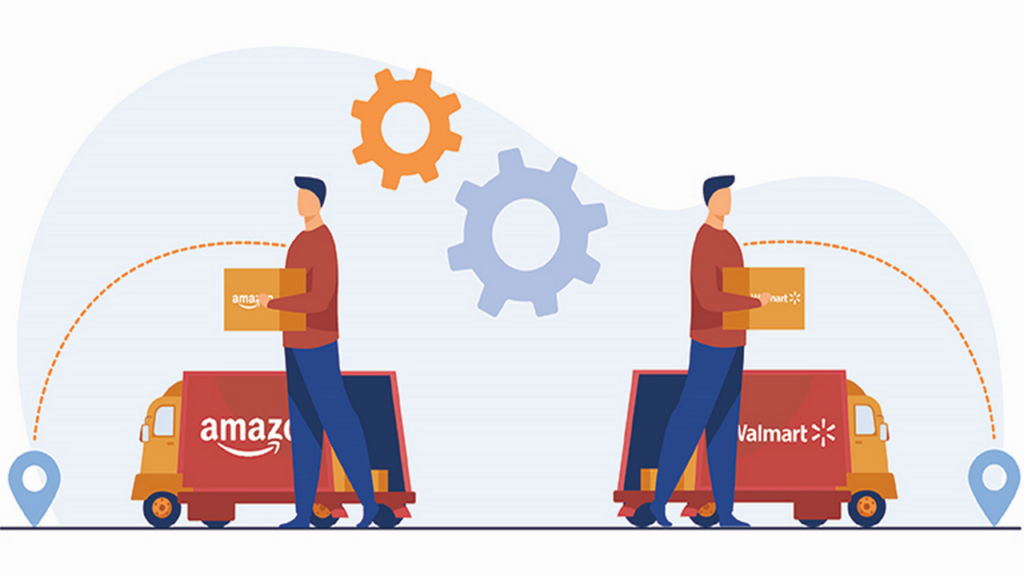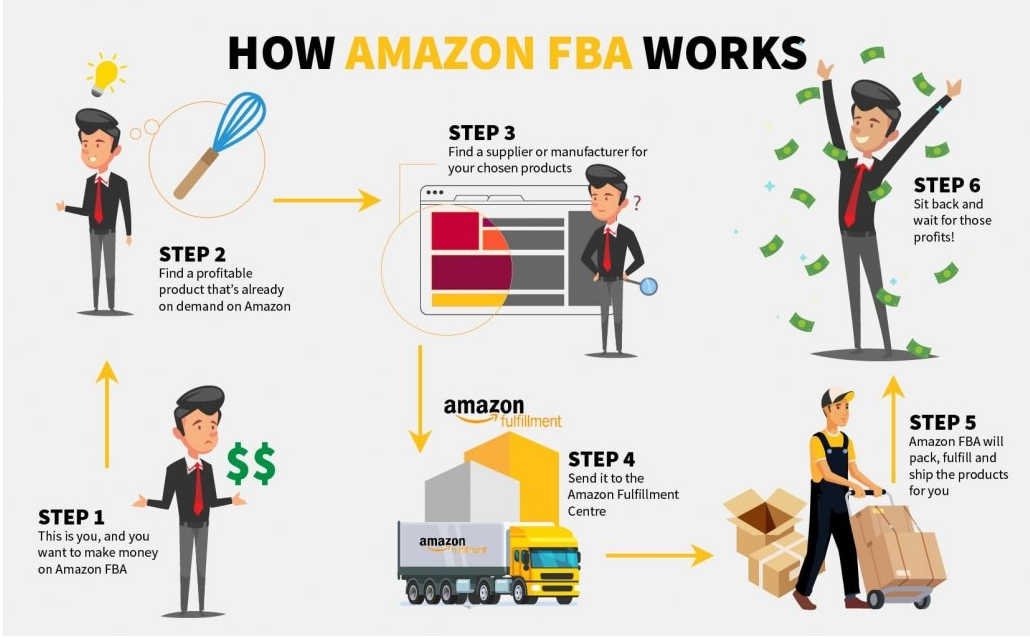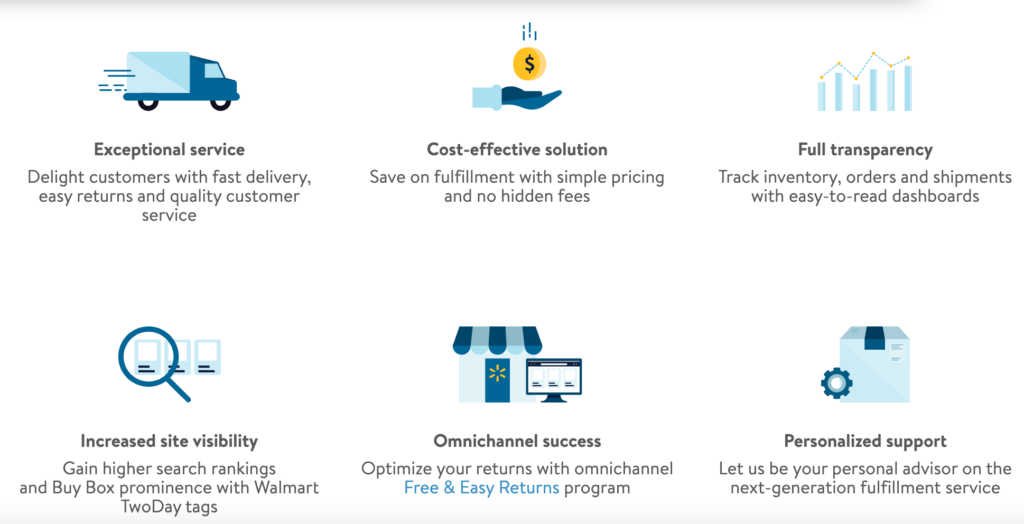What Is the Difference Between FBA and WFS?

As an e-commerce seller, you know that choosing a suitable fulfillment method is crucial for the success of your business. Two popular options are fulfillment by Amazon (FBA) and Walmart Fulfillment Services (WFS). Every alternative has benefits and drawbacks, and deciding which one to use can be complex. This blog will explore the differences between FBA and WFS to help you decide which option is best for your business.
What is FBA?
FBA stands for Fulfillment by Amazon. Amazon provides sellers with the option to store their products in Amazon’s fulfillment centers, which is a helpful service offered by the company.
This way, sellers don’t have to worry about packing and shipping the products. Amazon takes care of everything from picking, packing to shipping the products to the customers.
Benefits of FBA:
Prime eligibility:
When you use it, your products become eligible for Amazon Prime, meaning they will have the Prime badge next to them, making them more attractive to customers.
Amazon customer service:
Amazon takes care of customer service, including returns and refunds. It means you don’t have to deal with customer complaints or returns.
Multi-channel fulfillment:
FBA also offers multi-channel fulfillment, which means you can use Amazon’s fulfillment centers to fulfill orders from other sales channels, such as your website or other marketplaces.
How FBA works:

Shipping and storage process:
Once you register for FBA, your merchandise is shipped to Amazon’s fulfillment centers and kept there until purchased. Amazon handles the shipping and delivery process, including packing and shipping the products to the customers.
Order handling and returns:
When an order is placed, Amazon picks, packs, and ships the product to the customer. Amazon handles the return process if the customer needs to return the product.
Fees and costs:
FBA charges fees for storage, picking, packing, and shipping of the products. The price of the products fluctuates according to their dimensions and mass.
What is WFS?
WFS stands for Seller Fulfilled Prime. It’s a service that allows sellers to fulfill their products while still being eligible for Amazon Prime. Sellers have to handle the packing and shipping of their products themselves.
Benefits of WFS:
Control over inventory and shipping:
Sellers can have full authority over their stock and the shipping procedures, meaning they can choose their carriers and shipping methods.
Custom branding options:
It allows sellers to use their branding on their products, including packaging and shipping labels.
Lower costs for some sellers:
It can be less expensive for some sellers than FBA, as they don’t have to pay for storage, picking, and packing fees.
How WFS Works:

Shipping and storage process:
Sellers are responsible for storing and shipping their products to customers, and they can use their warehouses or third-party logistics providers.
Order handling and returns:
When an order is placed, the seller picks, packs, and ships the product to the customer. If the customer needs to return the product, the seller handles the return process.
Fees and costs:
Sellers don’t have to pay for storage, picking, and packing fees. However, they still have to pay for shipping and handling costs.
Comparison Between FBA and WFS:

Fulfillment Process:
The fulfillment process is one of the most critical aspects of selling products online, including everything from shipping and storage to the speed of delivery. Both offer similar fulfillment services, but some key differences exist.
- Shipping and Storage:
FBA offers shipping and storage services that are handled entirely by Amazon. Your items are kept in Amazon’s storage facilities and transported directly to the customers. WFS, on the other hand, allows sellers to choose their own shipping and storage providers, and it gives sellers more control over the process but also requires more work on their part.
- Speed of Delivery:
Both offer fast delivery options, but FBA tends to be faster overall. It is because Amazon has a more extensive network of warehouses and distribution centers than Walmart.
Inventory Management:
Another important aspect of selling products online is inventory management, from controlling inventory to restocking and tracking your effects.
- Control over Inventory:
With FBA, Amazon handles all inventory management, which means sellers have less control over their inventory and must rely on Amazon to keep track of everything. With WFS, sellers have more control over their list and can track it more closely.
- Restocking and Tracking:
FBA automatically restocks your products when they run low, while WFS requires sellers to fill their inventory manually. However, WFS allows sellers to track their inventory more closely and adjust as needed.
Cost Implications:
When deciding among various fulfillment choices, the cost is always a crucial factor to consider. Both charge fees for their services, but the total price can vary depending on the seller’s needs.
- Fees and Costs:
FBA charges fees based on the size and weight of the products sold and the storage space used. WFS charges fees based on the size and weight of the products, as well as the shipping and storage providers chosen.
- Total Costs for Seller:
The total cost of using both depends on the seller’s needs. In general, FBA tends to be more expensive overall but can be more cost-effective for sellers selling a large product volume, and WFS can be more cost-effective for sellers selling a smaller product volume.
Seller Control:
Finally, seller control is essential when choosing between FBA and WFS. It includes control over branding and customer service and flexibility in handling orders.
- Control over Branding and Customer Service:
With FBA, Amazon handles all customer service and branding; it means sellers have less control over how their products are presented to customers. With WFS, sellers have more control over branding and customer service.
- Flexibility in Handling Orders:
FBA offers less flexibility in handling orders, as Amazon handles all orders. With WFS, sellers can take orders flexibly and choose shipping and storage providers.
Conclusion:
In summary, there are several differences between the fulfillment process, inventory management, cost implications, and seller control. The seller’s specific requirements will determine the choice between the two options. Generally, FBA is more expensive but offers faster delivery and less work for the seller, and WFS is less costly and provides more control over inventory and customer service. Ultimately, sellers should consider their needs and preferences when choosing between both.
You May Also Like the following: How Satisfied Are Customers with Walmart Fulfillment Services?
FAQs:
Q1: Can I use FBA and WFS at the same time?
A: Sellers can use FBA and WFS for different or similar products.
Q2: What fees does the FBA charge?
A: FBA charges fees based on the size and weight of the products sold and the storage space used.
Q3: What fees does WFS charge?
A: WFS charges fees based on the size and weight of the products sold and the shipping and storage providers chosen.
Q4: Which is better for smaller sellers?
A: WFS is generally more cost-effective for smaller sellers, offering lower fees and more control over inventory and customer service.
Q5: Which is better for larger sellers?
A: FBA is generally more cost-effective for larger sellers, as it offers faster delivery and less work for the seller.